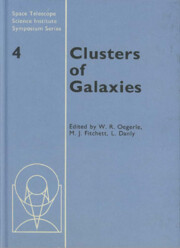Book contents
- Frontmatter
- Contents
- Preface
- Participants
- Chapter 1 Cosmology and Cluster Formation
- Chapter 2 Clusters of Galaxies: Structure, Infall, and Large-Scale Distribution
- Chapter 3 Cosmogony with Clusters of Galaxies
- Chapter 4 Cosmogony and the Structure of Rich Clusters of Galaxies
- Chapter 5 The Dark Matter Distribution in Clusters
- Chapter 6 The Effect of the Cluster Environment on Galaxies
- Chapter 7 Evidence for Gas Deficiency in Cluster Galaxies
- Chapter 8 Properties of Galaxies in Groups and Clusters
- Chapter 9 Dynamical Evolution of Clusters of Galaxies
- Chapter 10 Hot Gas in Clusters of Galaxies
- Chapter 11 Hydrodynamic Simulations of the Intracluster Medium
- Chapter 12 Evolution of Clusters in the Hierarchical Scenario
- Chapter 13 Distant Clusters as Cosmological Laboratories
- Chapter 14 Future Key Optical Observations of Galaxy Clusters
- Chapter 15 Cluster Research with X-ray Observations
- Plate section
Chapter 13 - Distant Clusters as Cosmological Laboratories
Published online by Cambridge University Press: 06 July 2010
- Frontmatter
- Contents
- Preface
- Participants
- Chapter 1 Cosmology and Cluster Formation
- Chapter 2 Clusters of Galaxies: Structure, Infall, and Large-Scale Distribution
- Chapter 3 Cosmogony with Clusters of Galaxies
- Chapter 4 Cosmogony and the Structure of Rich Clusters of Galaxies
- Chapter 5 The Dark Matter Distribution in Clusters
- Chapter 6 The Effect of the Cluster Environment on Galaxies
- Chapter 7 Evidence for Gas Deficiency in Cluster Galaxies
- Chapter 8 Properties of Galaxies in Groups and Clusters
- Chapter 9 Dynamical Evolution of Clusters of Galaxies
- Chapter 10 Hot Gas in Clusters of Galaxies
- Chapter 11 Hydrodynamic Simulations of the Intracluster Medium
- Chapter 12 Evolution of Clusters in the Hierarchical Scenario
- Chapter 13 Distant Clusters as Cosmological Laboratories
- Chapter 14 Future Key Optical Observations of Galaxy Clusters
- Chapter 15 Cluster Research with X-ray Observations
- Plate section
Summary
Abstract. Distant clusters provide ideal samples of galaxies in more-or-less standard environments in which to study the evolution of the galaxies themselves, bound structures, the larger-scale environment, and perhaps eventually to provide data for the classical cosmological tests. We review some of the the observational and theoretical aspects of these topics.
INTRODUCTION
Clusters of galaxies at large redshifts provide, in principle, a set of objects whose evolution can be traced directly from epochs as early as z ≈ 1 with present observational capabilities to the present. It seems almost inconceivable that large clusters are destroyed, and although it is quite clear that clusters are still forming, the inner regions of dense clusters must be quite old. Thus if one looks at galaxies in such regions and takes care to sample clusters whose comoving space densities are roughly the same at all epochs, it would seem as if one could define a quite homogeneous sample of galaxies in which the direct forbears of a set of present-day objects could be studied. We are not quite in a position to do that because the cluster catalogs are in such a sad state, but some progress is being made in this direction; we will discuss this at greater length below.
If one could choose clusters at epochs from the present back to large redshifts in some objective way, it would also be possible to study the evolution of the cluster population itself.
- Type
- Chapter
- Information
- Clusters of Galaxies , pp. 341 - 358Publisher: Cambridge University PressPrint publication year: 1990
- 6
- Cited by



